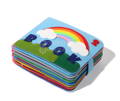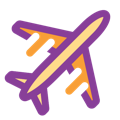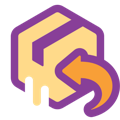Everything You Need to Know About Starting with Montessori Toys
Toys are an essential part of every childhood. They are more than just a fun pastime. They are learning tools that help children grow healthily and prepare them for the future in many ways. That is why it is so important that kids play as much as possible.
Playing is practically a full-time job for kids. Every aspect of child’s play serves to help them develop their skills and gain new knowledge.
However, not every type of play and not every type of toy has the same impact on your child’s growth. Some can help that development more, and some, unfortunately, a bit less.
What makes a good toy?
The more your child engages with a toy, takes a more active role, and challenges their abilities further - the better the toy.
Yes. You’re right - even smartphone games fit that description perfectly! Unfortunately, even though smartphones and technology are great accessories and can really keep children’s attention, they bring more harm than good.
Read more about why too much screen time can harm babies and the importance of ensuring children enjoy off-screen experiences.

Luckily, other toys can help develop skills without harming your child’s focus, attention span, and other abilities. Moreover, they help children acquire real-life skills. Kids love to know how to do stuff. Whether it’s tying their shoes, counting up to more than 10, or packing their own lunch, they like to act grown-up.
Maria Montessori discovered this more than 100 years ago, although she didn’t have video games to compete with. However, she discovered that children engage and develop most when learning real-life practical skills. Children in her class became more independent and more confident.
Nowadays, there’s a huge following of the Montessori way of learning, whether it’s through schools or toys. Before we dive into Montessori toys, let’s see the philosophy behind their design.
What Is the Montessori Method of Learning?
The Montessori method is a teaching approach that focuses on the child as an individual, encourages their independence, and emphasizes hands-on learning experience. It allows children to take the lead in their own educational journey by providing them with engaging materials that serve the purpose of educating the whole child. It aims to make children as self-sufficient as possible through play.
It was founded and named after Maria Montessori, who was one of the first Italian female physicians. She started practicing her teaching method in the Rome school she opened in 1907. The school was called Casa dei Bambini, and it was intended for underprivileged children.
Today, there are over 60.000 schools in the world applying the Montessori method in their curriculum.
Eventually, toy manufacturers realized the benefits of this approach and started applying it to their toy designs. In doing so, they had to follow five basic principles of the Montessori method that apply both to schooling and playtime.
What Are the 5 Principles of Montessori?
1. Independent play. When talking about this characteristic of Montessori toys and playtime, the focus is on providing children with such learning materials, or toys, that require no adults around. The goal is to make children as self-sufficient as possible; for that, they need to learn how to do things independently. This, in turn, will make them more confident and prepared for future challenges. Teachers and parents should act more like guides rather than lecturers in this scenario.
Also, children need to be free to choose what they learn and when. Freedom of movement and choice is a big part of independent play. What drives children’s education in this situation is their interest. The accent is on “their.” Montessori really believes that children learn best when they are allowed to follow their own interests and affinities.
2. Problem-solving mindset. Every day is just a series of “problems” ready to be solved. The more problems a person solves, the better they become at it. This is the philosophy Montessori closely follows. Children should be presented with all sorts of tasks and then left alone to solve them.
This nurtures a way of thinking that doesn’t make a child back away from difficulties. Instead, they learn how to think outside the box and find multiple solutions to a problem. Montessori toys are designed to do just that - motivate children to “think really hard.”
3. Focus on real life. This is where the Montessori method really stands out compared to others. Maria Montessori believed that young children should be exposed to reality-based stuff more than pretend play. Children under the age of 6 have a hard time distinguishing what’s real and what’s make-believe. That’s why in Montessori, there are no dragons, fairies, or superheroes.
So, what’s on the menu then? Children learn how to dress themselves, prepare their meals, keep their learning space clean, tidy their rooms, tend to gardens, and so on. Now, this might seem like work, but it’s not. Children learn all this stuff through play, games, and toys.

Don’t think that creativity and imagination are overlooked. They’re absolutely not. In Montessori, children spend a lot of time drawing, playing music, and learning with puzzles and building blocks, among other things. They also hear all sorts of stories, but they are based in reality, like where milk and honey come from.
4. Playing with purpose. The idea behind purposeful playtime is that it’s not just fun. It should be more than that. Children should learn through play. Luckily enough, that’s how children learn best. That’s why Montessori classrooms and toys are designed to help children both learn and develop various skills while having fun.
On top of that, children’s playtime should help their physical, emotional, social, and intellectual development. Kids focus on one task at a time but work on multiple aspects of their development simultaneously, also known as educating the child as a whole.
5. Every child is unique. Each child develops differently. They like certain things and dislike others. They also have an easier time handling one type of task and harder solving others. That’s why Montessori caters to each child according to the child’s aptitude and preferences. Montessori way of playing and learning takes an individualistic approach to help every child reach their full potential.
Now, let’s see how all of this translates to toys and toy design.
What Makes a Toy Montessori?
- Montessori toys are usually designed to have no flashing or irritating sounds and require no batteries. They are simple and invite children to take a more active approach to their playtime. The idea is to make children engage in their playtime and not just watch what a toy can do on its own. Not to mention that batteries can be really harmful.
- They are open-ended. This means that there is no one goal to their gameplay. Kids are encouraged to find as many gameplay possibilities with a single toy. They can stack them, combine them, use them to build stuff, draw around them, and so on. This type of playtime really helps boost children’s creativity and imagination.
- They are either real miniature tools or are based on real stuff. Something like a mini kitchen or tool set or these Montessori Geometric Eggs fit this description perfectly. They are fun, teach children about actual stuff that exists in the world, and train their skills at the same time.
- Montessori toys focus on one skill/task at a time. Having both too many toys or too many playing options on one toy can be too distracting. Focusing on a single task, however, helps children increase their attention span.
- They are challenging but not frustrating. This is maybe the most important aspect of Montessori toys. Finding that sweet spot between the two makes children fully engage with a toy, keeps their attention, and doesn’t make it boring after a few hours of play.
What’s the Best Age for Montessori Toys?
Any age works just fine. Actually, the sooner, the better. You can start as early as your child starts to engage with objects around them. Montessori infant toys are quite a popular baby shower gift. The whole point of Montessori toys is to provide your child with alternative playing options that will kickstart their love for learning and exploring.
Even if your child is older, it’s not too late. The only thing you need to consider when purchasing toys for your child is how far they are along their developmental milestone journey. Once you know that, you can start looking for toys that target those specific milestone skills. That’s the recipe for the best blend of fun, engagement, and learning opportunities.
How Do You Introduce Montessori Toys?
Of course, the Montessori way. Parents and teachers should be guides first. Once you receive your package of lovely Montessori toys, try presenting them to your child one by one. There’s no need to show them or explain anything yet. There are no wrong ways to play with a toy. Let your child explore their new plaything and see how they progress.
If they’re stuck with their new puzzle, don’t overexplain it. Simply join them and put a couple of pieces together to form a bigger picture. Make sure they see how you do it. By seeing and trying to replicate your moves, kids learn better than when they’re just following instructions.
Always remember to let your child take the lead. They should be the ones exploring and finding ways to enjoy their toys. Your main job is to worry about their safety.
What happens when you come to a point where you have too many toys lying around your house? That’s where toy rotation comes in.
What Is Montessori Toy Rotation and How Can It Help You?
Toy rotation is a brilliant idea that can save you space, time, and energy. It means that you need to make sure that your child has only a few toys available at a time while others are stored away.
The best thing about it is that it helps your child focus more on their toys and get more enjoyment from them. It’s quite simple, actually.

The first thing you should do is gather all your child’s toys in one place. Pick which of those toys stay and which are ready to be disposed of. Next, you want to categorize toys by the skills they help develop, like fine motor skills toys, drawing toys, puzzles, etc.
After that, you want to pick a single toy from each category. There shouldn’t be more than 8-12 in total. That group of 8-12 toys now becomes a single toy rotation. Create as many rotations as you have toys. The rest of the toys will be stored until it’s time for rotation.
Finally, set the rotation period. It can be every week, or two weeks, or once a month. You’ll see what suits you and your child the best.
The whole idea behind this is to allow your child to focus on fewer toys at a time. That way, they’ll engage in deeper play than when there are dozens of toys scattered around their room.
And once the rotation day comes, it’s like opening presents. New toys come into the rotation, and old ones go to the storage container. Try it out and see how it goes. Many parents said it helped them a lot.
What Are Some Best Montessori Toys for Starting Out?
Now that we know everything there is to know about bringing Montessori toys into your home, how to handle them, and most importantly, how they can help your child, let’s see what are some of the best suggestions for starting out your Montessori journey.
We sorted them by age and their complexity. You can always browse more Montessori toys by age if you wish to find further suggestions.
Starting with Montessori toys is one of the best things you can do for your child. It takes little effort, and the benefits are plentiful. Today, many parents are struggling to create a learning and supportive environment for their children, often with modern technology pitfalls working against them. Montessori is just the thing. It’s engaging, purposeful and prepares your child to become a self-sufficient and focused individual, set up for success.
Free Delivery
Over $80
Easy Returns
No questions asked
Unbeatable Warranty
1-year ++ warranty
- Secure CheckoutWorld’s most secure payment method












